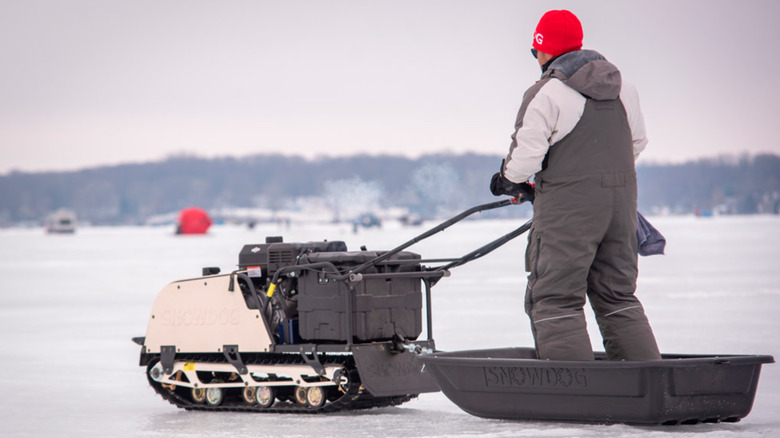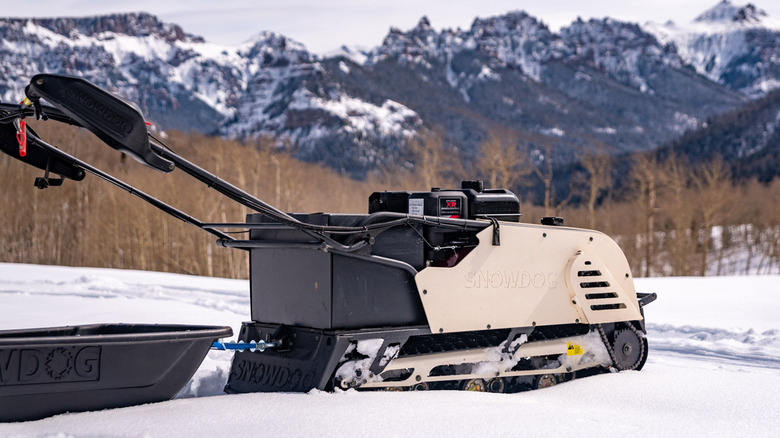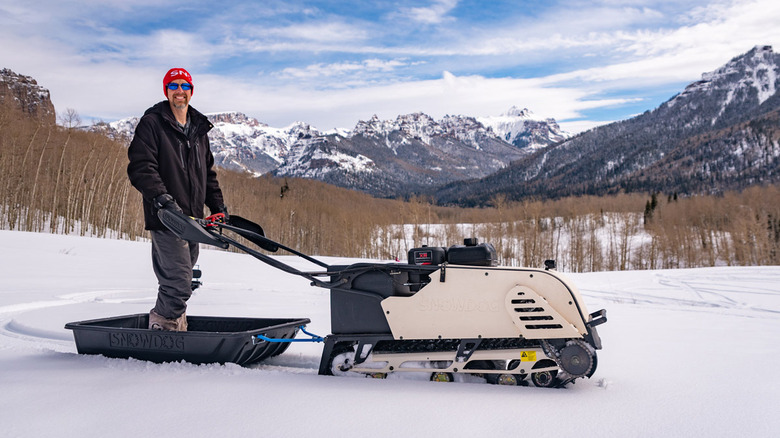What Is A Snowdog Machine, And What Are They Used For?
Severe challenges to mobility in snowclad regions have inspired the conceptualization of unconventional modes of transportation. While dog sleds have been a standard means of transport in the subarctic areas for thousands of years, personal snowmobiles have been used since the early 1960s. Meanwhile, a newer, more compact snow mover called Snowdog has piqued a lot of interest.
A Snowdog, essentially inspired by the dog sled, is a mechanical sleigh that combines an engine — with handles similar to a lawn mower — connected to trolleys or sleds that carry the rider along with other supplies or luggage.
Unlike a snowmobile, the Snowdog is primarily designed for single ridership and lacks any fixed or connected seats, although you can connect them as accessories. The rider — the musher, if you will — sits or stands on a sled tied to the primary vehicle in the front. Due to its barebones and unformalized design, Snowdog vehicles are also highly customizable and affordable compared to snowmobiles.
Uses and Challenges with Snowdog
Instead of skis as seen on snowmobiles, a Snowdog uses caterpillar tracks to maneuver over snow. This makes the Snowdog useful beyond regions of extreme snow and works equally well over dry terrains. The coupler design makes moving around in tight spaces easier, while the lightweight makes it easier to drive it over thin sheets of ice or even shallow rivers — as seen in the YouTube video above.
The compact design makes Snowdog machines more convenient to load in a trailer or a truck, making them ideal for outdoor activities such as camping trips, hunting, ice fishing, etc. Additionally, it can be used to groom slushy tracks for other forms of transport, such as snow bikes, work on a farm, or in the woods.
However, the same design and lower power than a snowmobile make it less practical for challenging elevation or sporting activities. Unlike a snowmobile, where the handle only steers the front skis, the Snowdog must be veered entirely for turning, making it relatively difficult to ride, especially if you are standing. Even with a lighter form than snowmobiles, the Snowdog can be trickier to dislodge if it gets jammed or upturned because it weighs around 300 pounds or about 136 kilograms.
Internal combustion and electric engines
Snowdog machines are typically driven by internal combustion engines — and preferred so because of the uncertain alpine regions. The Sports B13 — Snowdog's latest gasoline-driven model — is run by a 13.5-horsepower Briggs & Stratton single-speed engine with a 420 cubic-centimeter (cc) displacement. It features a 1.7-gallon fuel tank with a claimed efficiency of 0.8 gallons per hour, so you will need to carry extra fuel on longer journeys. The 2023 Snowdog adds a reverse gear, missing from older models, further aiding in mobility.
Based on official specs, the Sports B13 can carry up to 110 pounds (nearly 50 kilograms) of weight and tow up to 440 pounds (roughly 200 kilograms) in the leading sleds. Snowdog also comes in a "Pro" model with twin tracks powered by a Vanguard 400cc engine for better traction.
In 2019, Snowdog also introduced an electric version of the vehicle. Over the years, iterations to the electric "SnowdogX" have made it even more agile and powerful than the gas version. The SnowdogX is powered by a 9-kilowatt motor that delivers an equivalent of 13 horsepower. As per official specs, the electric variant can go as fast as 29 miles per hour.
Opposed to the single-speed gas engine, the electric version comes with two forward modes — economy and sport — and a reverse mode. It runs off a 60-ampere-hour battery, which can be charged within 2.5 hours using the supplied 25A charger.
Attractions over a snowmobile
To make riding more pleasant, Snowdog offers various features and accessories. First, heated handles come as standard on all models. Additional bells and whistles, such as handle mittens, swivel seats, cargo boxes, track groomers, or sliders with wheels — and the flexibility to add custom mods on the sleds — improve the Snowdog's riding experience. The electric model can also be stocked with an additional battery for a longer range.
What makes Snowdog machines much more attractive is their pricing. Compared to snowmobiles, which cost $15,000 on average, the Snowdog range begins at as low as $4,999 for the single track and $6,199 for the twin-track variant. Meanwhile, the electric, aka the SnowdogX, can be purchased for $7,499, making them a cheaper alternative to snowmobiles and ATVs. Expectedly, you miss out on facilities such as a cushiony throne or a pillion seat, elaborate instrumentation clusters, smoother suspension, or sportier designs. Most importantly, you get much less power compared to a snowmobile.
Instead, factors behind the Snowdog's appeal include ease of customization or the fact that you do not need to register in the U.S. at the moment since it does not qualify as an off-road vehicle (ORV) or motorized snow vehicle (MSV) —although regulations may vary with each state or change.


